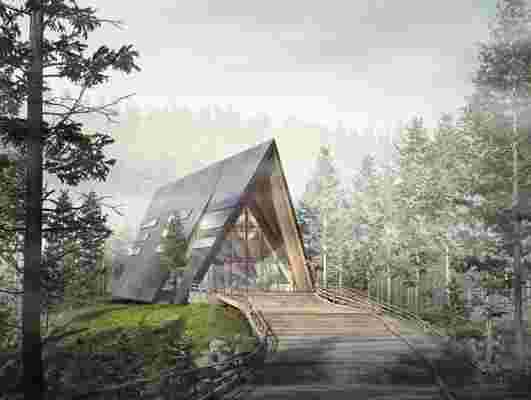When you picture a nuclear power plant, you probably imagine giant concrete cooling towers set within fenced-off industrial complexes. But the future of nuclear power has a very different look. California-based company Oklo is developing new clean energy plants that use advanced fission to provide areas with emission-free energy. The company recently received a site permit from the U.S. Department of Energy to build its first plant, the Aurora, at the Idaho National Laboratory. When working on the design, which was done in collaboration with Gensler, the company first considered the needs of the rural communities they hoped to serve in areas such as northern Alaska. “Right now they rely on diesel or oil,” says CEO Jacob DeWitte. “That’s obviously expensive. It’s also noisy, it’s polluting, and it’s susceptible to supply-chain disruptions.” The Aurora, on the other hand, produces 1.5 megawatt—enough to power about 1,000 homes—and can run for 20 years without refueling. It also would save 1 million tons of carbon emissions over a diesel generator and can turn nuclear waste into clean energy.
The small footprint of the technology gave the company the opportunity to devise an unexpected A-frame design for the structure, which looks more like a ski chalet than a power plant. “Aesthetically it alludes to the northern areas that we’re interested in serving,” says COO Caroline Cochran. “And it’s functional for the snow and precipitation in those areas.” The triangle shape also gives the structure strength to support the interior crane and has favorable heat-transfer characteristics, which can help performance. While most power plants have tight security, the advanced reactor technology Oklo is using allows the Aurora to be open to the environment—and even the public. The Aurora will have a light-filled front atrium that the company imagines could be used for a tourist or event space.
The A-frame’s exterior features solar panels using technology by Sistine Solar, a company that creates custom skins for panels. Each Aurora will showcase artwork by local artists. For the concept artwork, Oklo worked with artist Forest Stearns, who devised a piece based on an image of an aurora from space.

The triangle shape provides the structure strength to support the interior crane.
The team is also considering other ways to connect with each community the Aurora is installed in, such as building other amenities near the reactor. “We’ve discussed things like heated indoor swimming pool areas and indoor vertical gardens,” says Cochran. “Because of the long nights in the winter, these areas have huge problems with depression, and just getting to be in a lighted area indoors that has plants can be hugely beneficial for a community.” According to the CEO, indoor gardens would also help with local food supply. “Running and maintaining greenhouses is expensive from the energy side of things,” says DeWitte, “so having relatively abundant affordable energy supplies can really help change that paradigm so folks can have better access to foods that they may not otherwise have.”
Oklo just submitted a combined license application to the Nuclear Regulatory Commission and hopes that the first Aurora will be up and running in 2022 or 2023.
